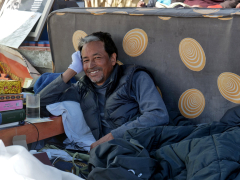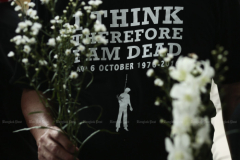New Delhi, India — On the night of August 5, 2019, hundreds of Kashmiris were arrested amid a crackdown by Indian security forces that followed the Indian government’s decision to strip the region of its special rights and status as a state.
Sonam Wangchuk celebrated and thanked Indian Prime Minister Narendra Modi.
Recommended Stories
list of 4 items
- list 1 of 4Indian police arrest Ladakh activist after deadly protests
- list 2 of 4‘Bloodiest day’: How Gen-Z protest wave hit India’s Ladakh, killing four
- list 3 of 4Video: Demonstrators killed in protests for statehood in India’s Ladakh
- list 4 of 4Photos: Climate change threatens yaks, herding culture in India’s Ladakh
end of list
“THANK YOU PRIME MINISTER,” he wrote on X, then Twitter, “for fulfilling Ladakh’s longstanding dream.”
One of India’s best-known innovators and education reformers, Wangchuk was referring to a decades-long demand from many in Ladakh for the cold desert bordering China to be separated from Jammu and Kashmir, the Indian-administered part of the disputed region that Pakistan also claims. Until August 2019, Ladakh was part of the former Jammu and Kashmir state. With the Modi government’s move, it was made a separate administrative entity, known as a union territory in the country, to be governed federally by New Delhi.
However, while the rest of Jammu and Kashmir — also reduced to a union territory from the state — was allowed to keep a locally elected legislature, Ladakh was not. That lack of any say over their future would slowly turn the peaceful Ladakh into a tinderbox of political unrest against Modi’s government in the subsequent six years. And leading that protest movement is a disillusioned Wangchuk.
On September 26, Wangchuk was arrested and transported about 1,600km (1,000 miles) from home to jail in Jodhpur, Rajasthan, charged with “anti-national” activities, conspiring to overthrow the government, after a breakaway group from his protest engaged in violent clashes with security forces. Indian paramilitary soldiers shot dead four protesters after they had set the local office of Modi’s Bharatiya Janata Party (BJP) on fire, and authorities accused Wangchuk of instigating the violence.
The same party and its government had previously turned to Wangchuk for promotional campaigns in Ladakh. BJP-led governments in other states had sought his advice as an educationist. Today, that one-time poster child, the inspiration for one of Bollywood’s most iconic and successful movies ever, stands accused of treason — with officials imputing a possible Pakistan hand behind his campaign for constitutional rights for Ladakh.
“Suddenly, in a month, the same government that was decorating him is calling him an antinational,” Gitanjali Angmo, Wangchuk’s wife, told Al Jazeera. “The writing is on the wall: this is to silence him, to scare him because they could not buy him.”

‘Grief in Leh’
Earlier in September, local activists in Ladakh, led by Wangchuk, began a hunger strike. It was the latest in a series of peaceful protests they had held in recent years, demanding constitutional protections under what is known as the Sixth Schedule. That statute allows parts of India that are predominantly inhabited by Indigenous tribes to have autonomous administrative and governance structures. More than 90 percent of Ladakh’s population consists of such tribes.
But on the 15th day of the strike, some youth-led demonstrators broke away and torched the BJP office in Leh, Ladakh’s capital, on September 24. Security forces fired back: four people, including a veteran soldier, were killed, and dozens were injured. The administration then launched a massive crackdown, arresting more than 80 people, including the protest leaders who had been sitting on a peaceful hunger strike.
Wangchuk was arrested under the National Security Act, a preventive detention law that allows imprisonment without trial for a year. More than a dozen local activists surrendered to the police in solidarity with Wangchuk and other detainees.
It was the worst violence and crackdown in the modern history of Ladakh.
Stanzin Dorje, a local businessman in Leh in his late 30s, had sat next to Wangchuk and others, joining the hunger strike. But amid the crackdown, he was — like the rest of Ladakh — restricted to his home under an unprecedented curfew-like deployment of armed forces on the streets of Leh. Dorje grew increasingly despondent, his friends said.
On Wednesday, Stanzin died by suicide. He is survived by his wife and two children.
“He was Sonam’s fan. He kept asking about him, kept taking his name,” said Tsering Dorje, the president of Ladakh Buddhist Association, a local group central to protests. Stanzin was also a member of the association’s general council. “He felt agitated and very sad. We are all asking, ‘What was [Wangchuk’s] crime? He was just sitting there. Why did they arrest him and send him to a jail outside [Ladakh]?” said Dorje.
Wangchuk’s rise from an engineer next door to an icon of Indian ingenuity and sustainable living made him a local icon, Dorje said, where young people looked up to him. “We are all grieving in Leh for our people, martyred or jailed,” he added.
A national hero
Born in Uleytokpo, a mountain village about 70km (44 miles) from Leh, in 1966, Wangchuk was home-schooled by his mother, Tsering Wangmo, till he was nine. In 1975, when his father, Sonam Wangyal, a politician, became a minister in the Jammu and Kashmir government, the family moved to Srinagar, the capital of Indian-administered Kashmir.
But Wangchuk struggled in Srinagar schools because he spoke only Ladakhi, while classes were taught in Urdu and Kashmiri. So he moved to New Delhi for high school and went on to study mechanical engineering at the National Institute of Technology in Srinagar. In 1988, soon after graduating, he cofounded the alternative school model SECMOL, or Students’ Educational and Cultural Movement of Ladakh, with other students to reform the education system in Ladakh.
Until then, nearly 95 percent of Ladakhi students failed their state exams amid a struggle with the curriculum, which was in Urdu — a language alien to many in Ladakh — and other cultural barriers. Urdu, spoken much more widely in Kashmir, was the dominant language of the state when it was a unified entity.
At SECMOL, the number of students clearing 10th grade rose from 5 percent to 55 percent in seven years, and then to 75 percent. Wangchuk also founded SECMOL Alternative School Campus near Leh, with only one admission criterion: a failing grade in regular schools. At SECMOL, students were taught through hands-on, experiential methods, like running radio stations, farming, repairing machines, and managing the campus themselves.
He was awarded the Jammu and Kashmir Governor’s Medal in 1996 for “reforming Ladakh’s education system” through his work.
Meanwhile, in the 1980s, Wangchuk’s father, Wangyal, also staged multiple hunger strikes for the recognition of Ladakh’s communities as Indigenous tribes.
In 1984, then-Indian Prime Minister Indira Gandhi flew down to Leh and offered Wangyal a soft drink in a symbolic outr





